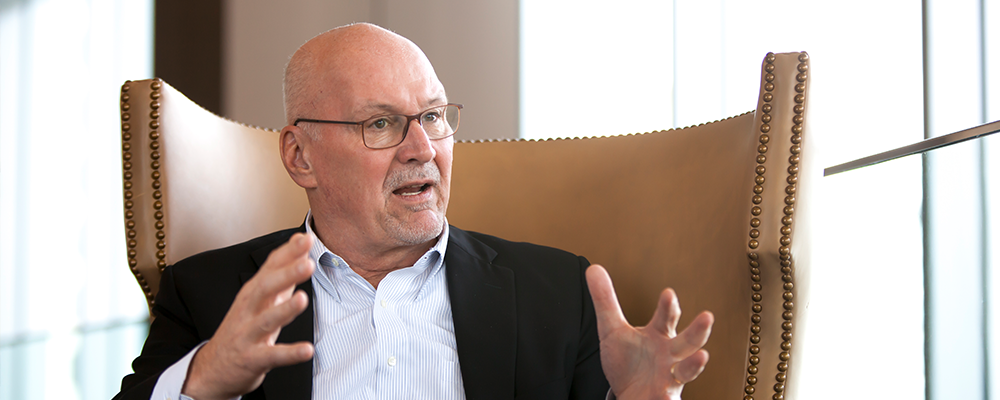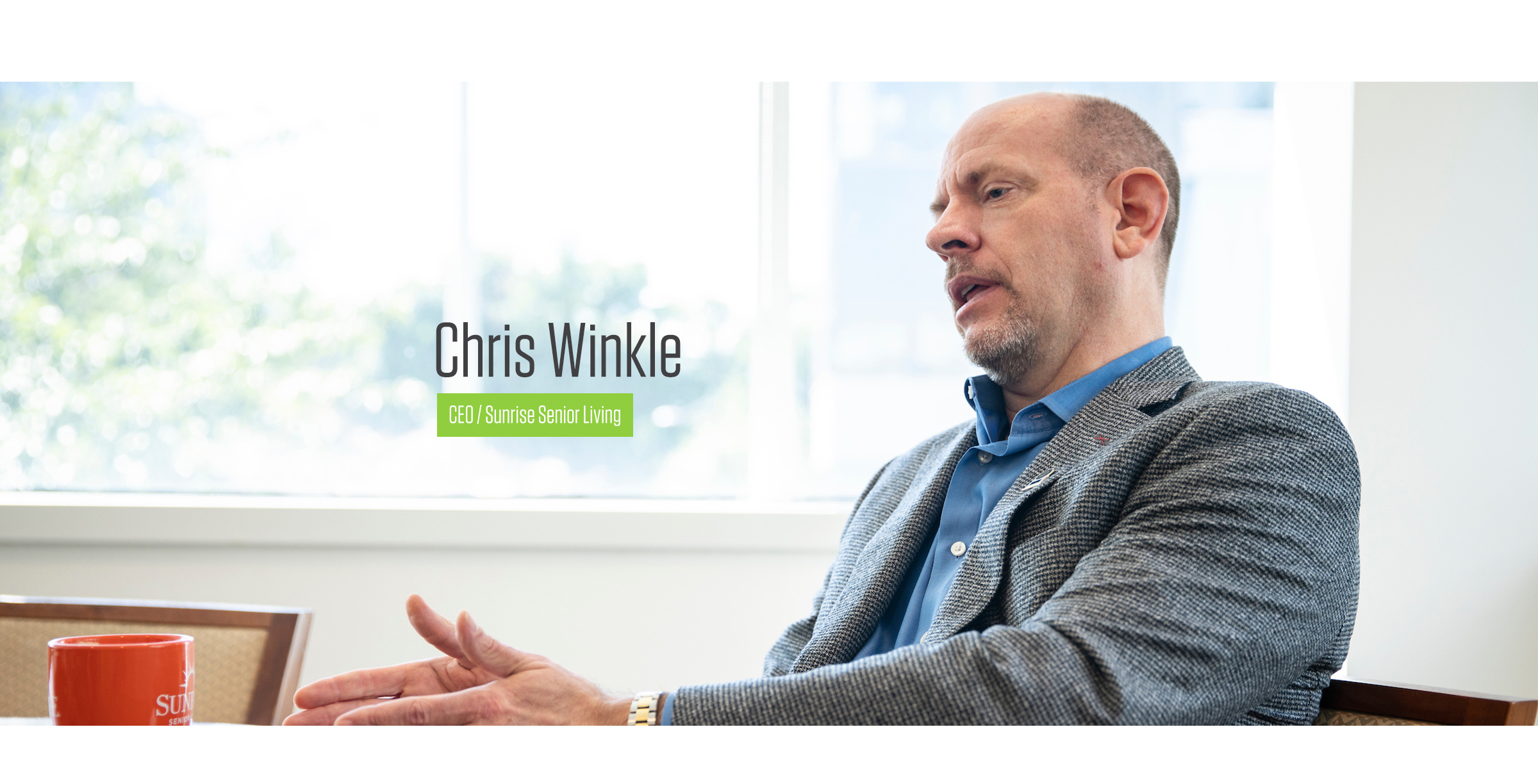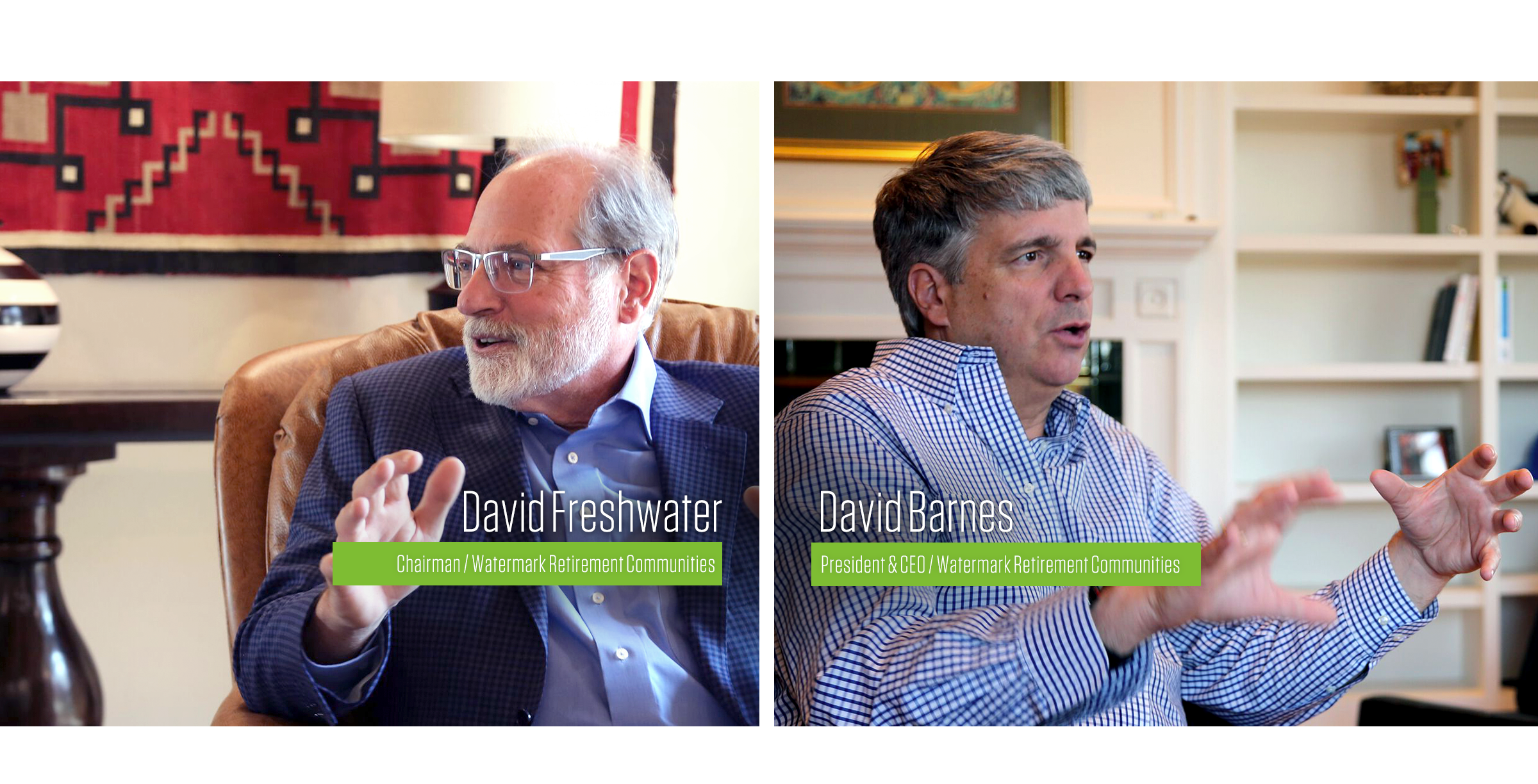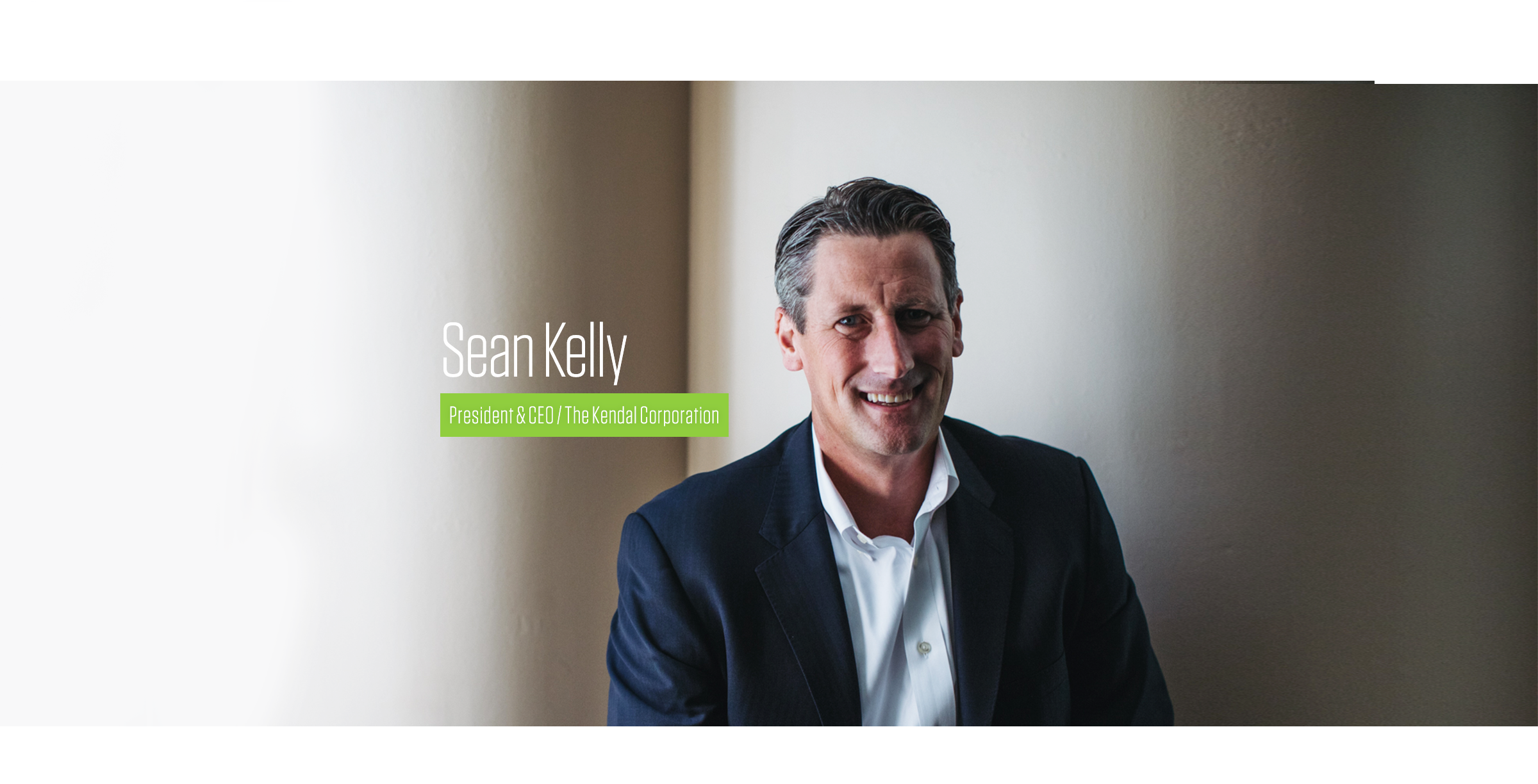Meet Jerry Finis, co-founder and CEO of Pathway to Living, based in Chicago. The company started in 1997 with the development of two communities in Illinois, and today counts 29 senior living communities comprising more than 2,000 assisted living units and more than 600 senior apartments. The company has established its track record of working with government financing agencies as well as private funding sources in order to create both affordable and private-pay senior living products for its residents.
Spotlight on Technology
Is Pathway to Living using technology to help manage your staff and ensure that that they’re engaged?
A lot of the things that we’re doing are to allow staff as much as we can to spend their time doing what they really would rather do: care for the residents. Hopefully this means less paperwork, make scheduling easier, or when we’re changing our record system, that should make the paperwork that they have to do a whole lot easier and more automatic.
The company has a strong focus on wellness programing and is on a calculated growth path under Finis’s leadership. We sat down with him to learn more about the “sweet spot” for Pathway to Living’s portfolio, why sometimes what you don’t know can actually help you, and why he sees sunnier skies ahead in light of current senior housing occupancy challenges.
Tell me about how you got into senior living.
I became involved back in the ’90s, and it was interesting because there was no grand plan. A lot of people in the industry got started from the real estate side, or from the acquisition investment side or from the development side. We got involved back in ’96 trying to get into the development business and sort of backed into doing affordable housing development utilizing tax credit financing. We started doing senior housing because that’s how we could get approved at a particular site.
It just sort of evolved that way.
At that point, what did you know about senior housing?
Not much, not much at all except that I had some apartments that had a bunch of seniors in them. That was about it.
Our first project was an affordable senior apartment which is age restricted and income restricted — which is really the apartment business — in Joliet, Ill., called The Victor Senior Center. Joliet Catholic High School was abandoned because they had merged the boys school with the girls school on the outside of town, so there was an empty school building. One of my partners, Jim Keledjian, at that time was talking to the village city manager in Joliet about something and they said, “You have to figure out what to do with this empty school building.”
We first figured out that we would do an affordable senior apartment, then we focused on an extra building on the site called the priory. The priory was basically the priest and brothers’ dormitory where the guys that taught at the school lived. Our investor was basically saying, “You’ve got to do something with that building. We can’t have another vacant building next to your nice new apartment you just renovated.” Around that time, Illinois was coming up with its Supportive Living Program, which was the Medicaid waiver affordable assisted living program they had. Just on a whim, we heard about it. We said, “Okay, we’ll try that.” Then they came out with an RFP. We applied and, for some unknown reason, we were selected.
Were there others who applied?
There were five or six companies that applied. We were awarded one of the first RFPs, and then we took it to our tax credit investor and to the state and the Housing Finance Authority and they financed it as an affordable housing deal. That was really the first one of those done in the state where we used senior-apartment affordable housing financing to finance an affordable assisted living building.
Like I said, no grand plan. It just sort of evolved.
What were you doing at the time?
We had some apartments. We did a lot of brokerage and owned a few things. Just a small real estate company. Just sort of tried to figure out what to do with the rest of our lives.
We still came in from the real estate side. We realized that we weren’t an operator. We found a management company that managed a bunch of small senior housing projects throughout Wisconsin, and they said they would manage those projects for us because, in the beginning, we found it very difficult to find a senior housing company that, number one, would manage a small building that was only 30 units; number two, would know anything about Medicaid; or number three, knew anything about affordable housing compliance and financing.
When we found this one company, we got it operating. Then, about halfway through the construction, we get a phone call that they can’t manage our project; they just declared bankruptcy.
Oh, shoot.
We’re like, “Okay, now what do we do?” That’s when we were trying to figure out, “How are we going to manage this thing?” and, “How do we do this?” I was talking with our banks at the time and they said, “I know a guy that can come and help us who’s been in the nursing home business and wants to do assisted living but knows nothing about real estate.” I said, “All right, we’ll talk to him.” His name was Brian Cloch.
Brian was in the nursing home business at that time and was working with the state of Illinois on their Medicaid rules and regulations surrounding this affordable assisted living Medicaid program. They put us together. We decided that when we’d set up Pathway senior living. He came in, he understood the operations of health care from the nursing home side. We understood the real estate, and we then went and we got the two projects, the Joliet senior apartments and Joliet supportive living facility done, and then we started going down the path.
I remember having a discussion with my work partner, Jim, at the time. I said, “Jim, after having done these two Joliet projects with all their complexities, either we’re doing a bunch of these or we’re never doing one of these again.” It was so many rules and regulations and they were programs that weren’t designed to work together. We decided to go down the path of doing a bunch, and over the next 10 to 12 years, we probably did 11 of our own supportive living communities. We did seven senior apartments. We did several senior apartment re-developments in the Michigan area, outside of Detroit.
We opened up the first senior apartments in 1997. We opened up our last development project in the affordable housing arena in January 2012.
By that time, it became obvious we were not going to be able to do more of the affordable assisted living because we couldn’t get an affordable assisted living project approved by the state housing finance authority because they had changed their targets. The RFP, it’s sort of the certificate-of-need setup. They weren’t coming out with new approvals.
Does Pathway still own those buildings? Even the one in Joliet?
Yes. The affordable housing financing required the equity investor to stay in for 15 years because that’s how the program is set up on the federal level. We bought out the partner. Our last project will come out of this long-term compliance in 2026.
You’re stuck.
Yes. The good news is we’re there. The bad news is we’re there a long time.
Did you ever think when you were starting the Joliet project that it was going to fail?
No. We didn’t know what we didn’t know.
We were very fortunate. We were very concerned about the state and the state paying and the state having the ability to pay. The state had a Medicaid budget crisis back in the early ’90s, and it put several hospitals out of business.
We were really fortunate to be able to go to all the housing authorities and create all kinds of financing vehicles that help create a lot of capital to weather the storm.
It was a challenge. The first day we got our first Medicaid check, and every time that happens, I always say, “I never know when we’ll get our next one.” It’s just such a willy-nilly thing.
You have since made the move to private-pay development. How does it compare to what you were doing before?
Our private-pay business has always been upper middle market. Everybody knows what high-end is, everybody knows what low-end is, but that middle market is really big. It’s hard to define that.
Some of our communities are very high end and get nice price points in the market. For other ones, it depends on the market.
Do you think you’ll ever go back to affordable development?
No, I’m probably too old for that, because from the day you look at a site to the day the compliance period ends is probably about 18 years. That’s too long.
Are you still in business with your same partners that you started with?
My original partner, Jim Keledjian, whom I started everything with, retired a couple of years ago. A couple of partners are the same, but we also brought in a company about two and a half years ago called Waterton, based out of Chicago. They invest in apartments and hotels.
What are your plans for the future?
Our model is to try to continue to grow. I think in new development, there are still so many opportunities of interest for developers and some more acquisitions.
What’s your sweet spot for the size of Pathway to Living’s portfolio?
Everybody says, “What’s too big or what’s not too big for a senior housing company?” We’re at 28 to 29 communities. My suspicion is, you probably got to get to somewhere around 50 communities and then you can take a pause and say, “Okay, now can I continue to grow? Do I have the infrastructure to grow? What’s it going to take?” Nobody really knows what the sweet spot is.
Everybody says, “What’s too big or what’s not too big for a senior housing company?” We’re at 28 to 29 communities. My suspicion is, you probably got to get to somewhere around 50 communities and then you can take a pause and say, “Okay, now can I continue to grow? Do I have the infrastructure to grow? What’s it going to take?” Nobody really knows what the sweet spot is.
Yes, but is 50 or so what you’re thinking?
Yes, something like that. There’s no magic to that. It’s just a round number that you hear.
Still figuring it out?
Most businesses start as small businesses, and they never really know how they’re going to grow until they start doing it.
Have you started to see the signs of pressure that’s now clear from the NIC data?
Yes.
Are you concerned about what’s coming?
There are stresses around the country and certain markets that are a little worse than others. I think it’s mostly how many new communities are opening at the same time. The old way was you’d have 10-year-old product, and then someone would build a new building and there was big difference. Now, there are two or three new competitors within seven to eight miles. I think it’s going to make things a little more challenging.
Do you think it’s going to get worse before it gets better?
No, I think it’s going to stabilize. I think things are slowing down a little bit in terms of the new development. I think some of the newer entries into the business are slowing because the capital markets are bringing a little more discipline. The banks are getting more restrictive. The equity providers more restrictive. The majority of equity providers have senior housing experience so they know what to look for. There isn’t as much new money in the space.
What are the equity providers looking for right now?
I think they’re looking for an experienced operator who has been through it and understands the business. I think they’re looking very objectively at locations and projects to see if they really believe that there’s a need and that it can compete. Especially if you’re in the assisted living and memory care space, they want to know that you really know what your market is. Your market is 88-year-old folks. Not 75-plus.
Especially if you’re in the assisted living and memory care space, [investors] want to know that you really know what your market is. Your market is 88-year-old folks. Not 75-plus.
We have to absolutely make sure that we understand what has to be done so we can bring in the appropriate care partners and coordinate them. When you have six home health agencies running in and out of your building all the time, you can’t control that.
Health Care vs. Hospitality
Is the coordination complicated?
The key is to try to set up your preferred providers. They’re needed in our records and everything else. We really work on getting that coordinated. To a certain degree, it’s hard to do, but it makes it easier when it’s done because you have this sort of comprehensive view of it.
How is Pathway to Living helping to coordinate them? Is there technology involved?
We’re in the process of updating and changing our system. These preferred providers join us at care meetings and director meetings all the time. It’s a very integrated approach.
Do you consider Pathway to Living a hospitality or health care company?
I think the way we would say it is that hospitality is wrapped around it. It’s a very health care-oriented business. Because they’re 88-year-old folks, they need it.
Do you ever get concerned about providing too much health care in your buildings?
There’s always a little bit of a concern about that, but much of the health care we bring in from the outside.
We were some of the first ones in the Chicago metro to have hospice services brought into the community when residents needed it. They had hospice service at home because that was their home. When you think about it, the average assisted living age is 88 to 90 years old. People have declining health and part of the reason they move into these communities is to not have to keep moving around. It’s just the nature of the services that have to be provided for that kind of resident.
Have you ever thought about actually bringing those services in-house?
Not really, because they’re separate entities with separate licenses. I think all those businesses have to stand alone. They’re great at what they do. The hardest part of that is trying to find folks that know how to deliver services in our kind of setting.
When did you start to say, “We need to be in the business of coordinating all the certain types of care?”
Over 10 years ago.
Is Pathway to Living using data to ensure you’re meeting particular outcomes?
Yes, we track a lot of data, and we continue to track more. We’re upgrading our electronic health and wellness system, which will give us a lot more information. As we continue to get all the data, what we do and what our health providers do makes a big, big difference.
What are you planning on doing with the data?
We’re helping reduce hospital readmissions and initial admissions and slow down some of the 911 calls. I think we’ll soon start to share a lot of that information with the payers, such as the managed care organizations [MCOs].
Most of it is still private pay with an individual payer, but over time that’s going to change. On the affordable side, they’re wanting to understand all this information.
Once they do that, that information is more important. They can say: “You should go to this community over here and not that one over there.”
Do you think assisted living has a place in managed care?
Yes, because it can be preventative. Once residents go to the ER, it starts a cycle. Anything that we can do from a preventative way to minimize that, that’s where we’ll save that system a lot of money.
We’re also by definition a chronic care management business. It makes sense because we’re trying always to deliver care in the lowest-cost setting possible and assisted living is a lower-cost setting than skilled nursing or something along those lines.
One of the things I keep hearing about is the resident experience. What is Pathway to Living doing to enhance the resident experience?
We’ve created a residence experience called VIVA! VIVA! is our culture, as we’ve been calling it, that helps to find how we interact with the residents. Are we engaged? It’s really a lot about helping them do versus doing for them. It drives the internal and external branding for us. To help our residents know and their families know what they might experience when they come to live with us. Or help define the behaviors or the expectations of the employees.
Are you able to track the effectiveness?
We keep trying to do that. It’s more intuitive. Eventually we’d like to say yes. Maybe not so well yet.
LEADERSHIP
During your senior housing career, what’s the biggest challenge you’ve faced?
Growing from a small operator. We hired our first HR director and one of the other partners said “Tell me what HR does.” He had no idea.
When you start as a small real estate entrepreneur, which is just a couple of people working together, you don’t think about these things. Like I said, there’s no grand plan, and having never come from a large organization, all of a sudden you have to have these systems and processes in place when you grow.
Did you ever have a point where you thought: “What have we done?”
I can tell you that when we started, we had no concept that we would be here today like we are.
What’s the biggest risk you’ve taken in your career?
When we got started on the affordable [side], that was risky at the time. We didn’t know what we didn’t know. Because it was relatively new with the state, the biggest concern when we had done a couple of these projects was that it was a government program that could just be erased someday. Eventually the industry got large enough and made it harder to do that, but government can do what it wants to do, so we have to be prepared. Knowing what I know now, would we have done as many of those? Probably not, because I would have said there is a lot of risk.
What’s the best piece of advice you’ve received in your career?
If you’re doing it for the right reason and you believe in what you’re doing, it will pull you through the tough times, where you really start to question: Why I am doing this?
If you’re doing it for the right reason and you believe in what you’re doing, it will pull you through the tough times, where you really start to question: Why I am doing this?
Whom do you consider to be your mentor?
It’s probably my dad. He was always in business for himself. He worked really hard, probably too hard. He didn’t have too many things that he did besides work, but it really gave me a discipline.
What’d he do?
He had a temporary calculating service—this was before computers—where they would take inventory cards from businesses like Marshall Field’s and they’d have rows and rows of people working on the adding machines, tallying up the inventories. Then when computers came around, they basically overnight wiped out that whole business.
That must have been hard.
It was. And I was pretty young at that time, so I didn’t understand it as much, but you realize how much you think you control what you really don’t control. The whole idea there in my mind is: You’re going down the direction you’re going, but boy, you better not have blinders on. You better be watching around as much as you can because those things will happen.
There are a lot of people who are starting to try and start operators. As an entrepreneur, is that fun for you to watch?
It’s interesting. A lot of folks who seem to be starting out came from larger organizations. I think they’re going to bring a lot of changes and fresh ideas to the industry.
Do you have any advice for them?
I think they will have to make a decision at some point, how big they want to get, because if they get too big too quick, it might not be a good thing. The good news is they came from another company. They’ve seen it happen. In my generation when we all started, we just didn’t know anything. We just started doing; we didn’t know what tomorrow was going to bring.









